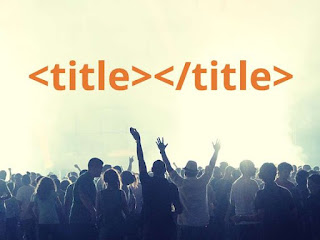What Is a Website Title and How to Write the Perfect
In the vast digital landscape, a website title holds significant importance. It serves as the first impression for visitors and plays a crucial role in attracting attention and conveying the essence of an article. In this blog post, we will explore what a website title is, its purpose, and provide tips on crafting the perfect title for your articles.
What's a Website Title
A website title, also known as a headline or title tag, is a concise and descriptive phrase that summarizes the content of a web page. It appears prominently in search engine results, browser tabs, social media shares, and bookmarks. A compelling title captures readers' interest and entices them to click and explore further.
In the realm of online content, a website title holds immense power in capturing readers' attention and enticing them to explore further. It serves as the gateway to your content, often determining whether someone clicks on your link or scrolls past it. In this blog post, we will dive into the world of website titles, exploring their significance, components, and best practices for creating captivating titles that drive engagement.
Importance of Your Web Page Title Tag
The primary purpose of a website title is to provide a clear and concise representation of the article's topic. It should accurately convey the main idea and spark curiosity in potential readers. Additionally, a well-crafted title can improve search engine optimization (SEO) by including relevant keywords and attracting organic traffic.
A web page's title can be specified using the title tag, an HTML element. It appears in the title bar of a browser and as the clickable headline in search engine results. The primary purpose of the title tag is to provide a concise and accurate description of the page's content, helping users understand what to expect when they visit your website.
Tips for Writing the Perfect Website Title
Clearly indicate the article's subject matter in the title. Avoid vague or misleading titles that may confuse readers or fail to accurately represent the content.
2) Grab Attention with Creativity
Use attention-grabbing words, intriguing questions, or compelling statements to capture readers' interest. Consider incorporating power words, numbers, or emotions to make the title more memorable.
3) Keep it Concise
Choose a title that is brief and direct. Ideally, it should be around 50-60 characters to ensure it appears fully in search engine results.
4) Incorporate Relevant Keywords
Research and include relevant keywords that align with the article's topic and are commonly searched by your target audience. This can enhance the title's visibility in search engine rankings.
5) Use Proper Formatting
Capitalize the first letter of each major word in the title, while avoiding excessive capitalization. Use appropriate punctuation and avoid using all caps, as it can be perceived as shouting.
6) Test and Refine
Try out various title modifications to discover which ones work best. Monitor analytics and user engagement metrics to identify which titles generate more clicks and engagement.
7) Target a Specific Audience
Tailor your title to resonate with a specific target audience. Use language, terminology, or references that appeal to that audience. Take "The Ultimate Guide for Tech Enthusiasts: Mastering the Latest Gadgets," as an example.
4 Examples of Effective Website Titles
1) 10 Effective Strategies for Boosting Your Website Traffic
2) The Ultimate Guide to Social Media Marketing for Beginners
4) The Power of Mindfulness Transform Your Life with Daily Practices
The Power of Mindfulness Transform Your Life with Daily Practices
1) Evoke Emotion
Appeal to readers' emotions by using words that elicit a specific emotional response. Whether it's curiosity, excitement, or empathy, tapping into emotions can make your title more compelling and memorable.
2) Include Numbers or Statistics
Incorporate numbers or statistics in your title to convey specific information and add credibility. Take the topics "7 Proven Ways to Increase Your Productivity" or "The Latest Research: 90% of Users Prefer Video Content," for instance.
3) Solve a Problem
Highlight how your article addresses a particular problem or provides a solution. This can attract readers who are actively seeking answers. For instance, "How to Overcome Writer's Block and Boost Your Creativity."
4) Create a Sense of Urgency
Instill a sense of urgency in your title to encourage immediate action. Words like "now," "quick," or "essential" can create a sense of time-sensitivity. For instance, "Act Now: Limited-Time Offer for 50% Off!"
5) Add a Unique Twist
Stand out from the crowd by adding a unique or unexpected element to your title. This can pique curiosity and make readers more likely to click. As an illustration, consider "The Surprising Science Behind Procrastination: Why We Delay and How to Overcome It.
6) Consider SEO Keywords
Research and incorporate relevant SEO keywords into your title to improve search engine visibility. However, ensure the title remains natural and compelling for human readers, avoiding keyword stuffing.
7) Test Different Formats
Experiment with different title formats, such as lists, questions, statements, or comparisons, to see which resonates best with your audience. Test variations and track the performance to refine your approach.
8) Include Targeted Keywords
Incorporate relevant keywords related to your article's topic to improve visibility in search engine results. However, ensure that the title remains clear, concise, and engaging for readers.
9) Use Social Proof
If your article includes expert opinions, testimonials, or case studies, mention it in the title to establish credibility. For example, "Top Fitness Tips from Leading Personal Trainers" or "Success Stories: How These Entrepreneurs Built Million-Dollar Businesses.
Conclusion
A well- crafted website title is an essential element in attracting readers and conveying the essence of your article. By understanding the purpose of a website title and following the tips outlined above, you can create compelling and engaging titles that entice readers, improve SEO, and drive traffic to your content. Remember to experiment, analyze results, and continually refine your approach to optimize the effectiveness of your website titles.



.jpg)
%20(1).jpg)










0 Comments